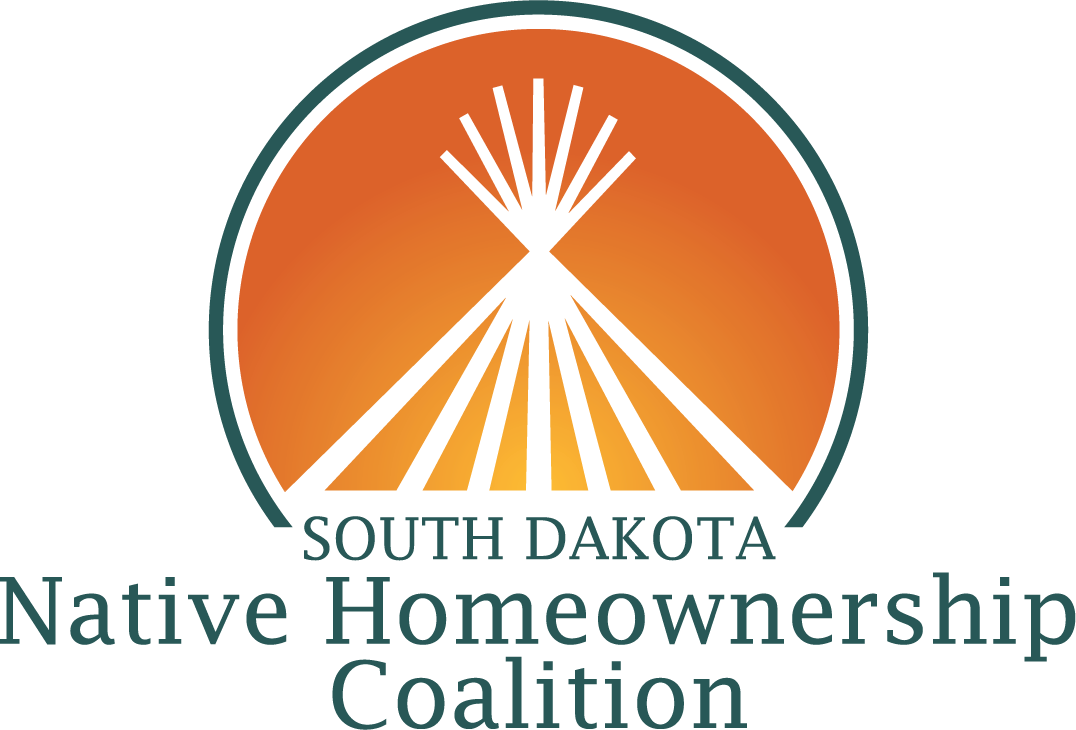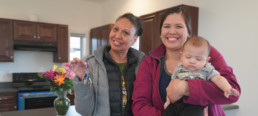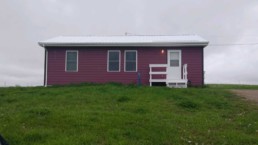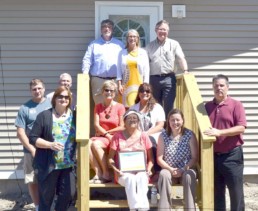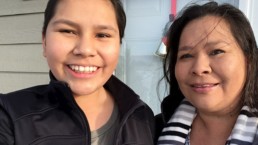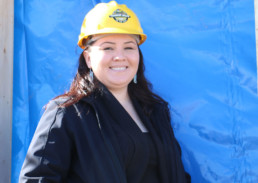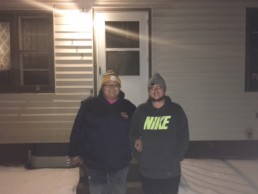Debra Phelps Becomes 5th Homeowner in Thunder Valley Regenerative Community
Although many things came to a halt with the onset of the COVID-19 pandemic, some aspects of life carried on. After nearly a year of hard work and dedication, Debra Phelps, a Sisseton Wahpeton Oyate tribal member and a Marine Corps veteran, became a first-time homeowner at the end of March, when she purchased a 3-bedroom, 1 ½ bath home in the Thunder Valley Regenerative Community on the Pine Ridge Reservation in South Dakota.
Although she hadn’t thought of it yet, Debra began preparing for homeownership a year before she actually began the mortgage process. As an employee of Thunder Valley Community Development Corporation (TVCDC), she was required to complete financial literacy classes.
“I’m up there in age, so I thought I knew everything about financials. I’m glad we had to do it, though. It makes you think about things you hadn’t before,” says Debra.
That was a turning point for her. She took some steps to increase her credit score, and also started talking to her three grown children about credit. Most importantly, she began transforming her financial habits.
“I started paying attention to my spending and asking myself at the cash register if this was a need or a want,” she explains.
As time went on, Debra began thinking about aging and her future. “I didn’t want to put the burden on my kids, so that is how I started thinking about homeownership.”
Debra began working with her colleagues, Ana Garibaldi and Star Means who are part of the Housing and Homeownership Initiative at TVCDC, to become mortgage-ready, figure out the best-fit loan product, and identify potential subsidies. Ana and Star are also active participants on the South Dakota Native Homeownership Coalition’s Homebuyer Readiness Committee and Native Veterans Homeownership Committee. Debra says the most challenging thing along the way was the paperwork.
“There is a lot to know – what you are reading, what it really means. It is a scary process if you don’t know what you are doing, but Ana and Star were there to help me through it,” says Debra.
TVCDC leveraged partnerships with Oglala Sioux Lakota Housing and the South Dakota Housing Development Authority to help Debra secure over $50,000 in subsidies to offset loan processing fees and construction costs. Ana from TVCDC explains that the subsidies are a critical piece to making homeownership possible for many people, especially because construction costs in a rural area average about 20% higher than in urban areas.
“We really appreciate our partners, because the subsidies are key to making homeownership affordable on the Pine Ridge Reservation. They help keep monthly mortgage, property tax, and insurance payments within a reasonable range for our homeowners,” says Ana.
Debra says the most rewarding part of her homeownership journey was getting approved for her VA Home Loan, which was through First National Bank in Rapid City.
“I always wanted to own my own home, but I never thought I would or could. Just being able to qualify was good,” she says.
Debra loves her new home, especially the high ceilings on the first floor, natural light, and mud room that is really great for her two dogs. She is still getting used to the idea of being a homeowner, though.
“Sometimes when I turn on the TV, I worry about being too loud. I’ve lived in apartments my whole life, and I forget that I’m in my own home and I can be as loud as I want,” she laughs.
Debra looks forward to helping her children become homeowners when they are ready. In the meantime, she continues to provide guidance on credit and spending.
“This was another thing I was able to experience before them, so I can help them with it when they go through it,” she says.
Eighth Renter Transitions to Homeowner in Eagle Nest Housing Development
In the midst of an extreme housing shortage, it is estimated that the Pine Ridge Reservation needs an additional 4,000 homes to provide adequate housing for residents. With a virtually nonexistent residential real estate market, families are commonly on the waiting list for low-income tribal housing for two-plus years. In the meantime, they are “doubling up” or even “tripling up” – terms used to describe multiple families living in a single-family residence – so that their basic needs for shelter are met. As a situation that has spanned several generations, this has become a way of life on the Reservation.
“A lot of people don’t know anything about homeownership or mortgages. We hear about homeowners in the city, but not here,” explains Carrie Sitting Up who rented a home in the Eagle Nest Housing Development, located in the northeast corner of the Reservation.
However, that is beginning to change. As the first Native American Low-Income Housing Tax Credit (LIHTC) project in the country, Eagle Nest has provided affordable rental housing through its 30 single-family units since 1999. When the tax credit agreements reached maturity a few years ago, Lakota Funds, a nonprofit organization who developed the housing track and also a member of the Coalition, began converting the rental units into privately-owned homes.
Since then, they have been working with tenants to prepare them for homeownership by providing financial coaching, homebuyer readiness training, and other resources. During the Coalition’s 2017 Tour & Convening, we visited Eagle Nest and saw first-hand the progress they were making. The first sale in Eagle Nest closed in late 2017, and to date eight homes have sold!
Seeing another tenant become a homeowner inspired Sitting Up. She says, “I liked the outcome of her home. I didn’t think it was possible until I talked to her about it, and it gave me some motivation.”
Sitting Up’s homeownership journey began with getting her finances in order. She says this took some time, because she needed to clear up some debt. But, she was able to utilize Lakota Fund’s Credit Builder Loan to help her with this step.
“It was a beautiful experience, because I was able to figure out my finances on my own and take care of myself,” says Sitting Up.
She was moving through the loan application process with Mazaska Owecaso Otipi Financial, a community loan fund in Pine Ridge and also a Coalition member, when her father passed away in September 2018. After a time of grieving, she says she gathered herself together and sealed the deal.
She reflects on her loan signing, “I really cried, because my dad would have been so proud of me.”
As the first in her family to become a homeowner, Sitting Up says, “I feel like I won a grand prize buying this home.”
Sitting Up rolled several improvements – new windows, doors, siding, and roof – into the purchase of her home. There were other minor repairs, but she wanted to fix those on her own so she could experience the real meaning of homeownership. That is a decision that also kept her mortgage payment, which is comparable to her rental payment, more affordable.
“I’m still learning. Owning a home is a big deal, and I have experienced a bit of a struggle. But I knew I had to do it, because it was important to me,” says Sitting Up. Although it wasn’t easy, she says homeownership has given her structure in her life and it has been a positive step.
Sitting Up is planning a house warming party to celebrate her one-year anniversary of homeownership this Fall. She hopes her story will inspire other people to achieve homeownership.
“I love my home, and I’m really happy living here,” she says.
Nearly 12,000 People Reached Through “Native Homeownership is Possible” Campaign
On November 5, 2018 the South Dakota Native Homeownership Coalition launched a week-long social media campaign designed to spread the message that “Native Homeownership is Possible” throughout Native communities in the state by utilizing the series of Native homeownership videos we produced. To help our stakeholders engage in the campaign, we developed a Social Media Toolkit with sample posts, a collection of shareable images, and hashtags.
We are pleased to announce that the campaign was incredibly successful! It gained momentum each day, and our message reached far and wide. Here’s what we accomplished:
- Reached 11,869 people through Facebook posts.
- Engaged 519 people through Facebook posts.
- Drove 58 people to the nativehomeownership.com site to seek out homeownership resources or watch additional videos.
- Accumulated 453 views of the videos in the “Native Homeownership is Possible” series.
And some more great news… The content we published during the campaign will continue to have an impact in Native communities. As a result of the campaign, we seeded the idea of homeownership in nearly 12,000 minds. Not all of those people will act right away, but 58 people did take the first step on their homeownership journey by seeking out more information on our nativehomeownership.com website. We can’t wait to see more and more Native families becoming homeowners!
Campaign Participants
The campaign was made possible by our stakeholders that mobilized to help spread the critical message that homeownership is possible in Native communities. We’d like to thank the following people and organizations for sharing and posting content to support a broader reach of the campaign’s messaging:
Juel Burnette
Chance Renville
CRHA Homebuyer Readiness
Andrew Boyd
Lisa Whitewing
Tony Wood
Dowell Caselli Smith
Northwest Area Foundation
GROW South Dakota
Enterprise Community Partners
Lakota Funds
Lakota Federal Credit Union
Homes are Possible, Inc.
Christine Sorensen
Ana Catches
Sweet Grass Consulting
Lesa Jarding
Coalition Partners Join Forces to Make Homeownership Dream a Reality
In early June, Sherry Morgan, an enrolled member of the Crow Creek Sioux Tribe, realized her dream of homeownership with the help and support from several of our Coalition members. She now owns a home located on her parents’ leased land where she lived as a young girl.
In recognizing her great accomplishment, a celebratory event was held at Sherry’s home on June 5, 2018, and attended by several partner organizations, family, and community members. During the event, a Crow Creek elder blessed Sherry’s home, and an honor song was performed by the local drum group Bad Nation. USDA Rural Development Director, Julie Gross, presented Sherry with a certificate, and a meal was shared by all who attended.
During the event, Sherry said,
“The feelings are overwhelming for me as a first-time homeowner. Having this home built on the previous site of where my mom and dad lived makes it bittersweet.”
The innovative way in which Coalition members worked together created a path to homeownership for Sherry. This project is USDA Rural Development’s first 502 New Construction Direct Loan with the South Dakota Housing Development Authority’s Governor’s House Program on the Crow Creek Indian Reservation. USDA Rural Development leveraged the 502 Loan with Federal Home Loan Bank’s Native American Homeownership Initiative (NAHI) program through Dacotah Bank, as well as the Crow Creek Housing Authority to assist Sherry with the purchase of the Governor’s House. She also received funds through the Homes are Possible, Inc. (HAPI) grant program for closing costs.
Although Sherry’s homeownership journey was nearly two years, she was driven and committed through the entire process. She hopes that by sharing her story, it will inspire others to jump in with both feet to obtain homeownership.
Coalition Launches “Native Homeownership is Possible” Campaign
We are pleased to announce that we have launched our “Native Homeownership is Possible” campaign through a new website at www.nativehomeownership.com. The website includes a series of short videos designed to:
- Raise awareness of the concept of homeownership in reservation communities.
- Implore that homeownership is possible for Native Americans.
- Inspire and encourage Native American individuals and families to start on the path to homeownership.
In addition, the website features contacts listed by reservation and off-reservation areas that people can access to start on their path to homeownership.
We encourage all of our stakeholders to share these inspiring videos to help spread the message that “Native Homeownership is Possible.”
Family Celebrates Homeownership this Holiday Season
During the Coalition’s annual site visit this past summer, we learned about the Eagle Nest Housing Development on the Pine Ridge Reservation and how some of our stakeholders were creating homeownership opportunities there. We are pleased to share this story about the first family in the development that has transitioned from renting to homeownership.
This holiday season, Cynthia Plenty Bull and her daughter will be celebrating in the same house they have lived in for the past six years. But this year, they will call the home their own. Cynthia is the first tenant in the 30-unit Eagle Nest Housing Development, originally built in 1997 as low-income rental housing, to make the move to homeownership.
For Cynthia, owning her own home means stability. This is especially critical on the Pine Ridge Reservation, an area with an extreme housing shortage where it is estimated that an additional 4,000 homes are needed to provide adequate housing for residents.
“When you are a homeowner, you don’t have to wonder when it will end or if your lease is going to increase and you won’t be able to afford it anymore,” Cynthia says.
When it was constructed, Eagle Nest Housing Development made history as the first Native American low-income housing tax credit development in America, and since then has provided families with affordable housing. The project was designed as a rent-to-own development, where families would have the option to purchase their homes. As the tax credit agreements have reached maturity, Lakota Funds, who owns the development and also an active Coalition member, is reaching out to current tenants and supporting those interested in transitioning from renting to homeownership.
“Although Lakota Funds has invested a lot into Eagle Nest over the last 19 years, our goal was never to turn a profit. It has always been about creating homeownership opportunities, and our board approved a sale price of the homes to make it affordable for the families in the area,” says Tawney Brunsch, the Executive Director of Lakota Funds.
Cynthia began her homeownership journey this summer by contacting Lakota Funds. Lakota Funds then referred Cynthia to Mazaska Owecaso Otipi Financial, a nonprofit loan fund that provides home loan products and also a Coalition member.
Cynthia comments, “They [Mazaska] would tell me step-by-step what to do. We sat down and they talked to us through the whole process. It wasn’t a scary thing.”
Working between the two partner organizations and her bank over the next five months, Cynthia was connected to all of the resources and capital she needed to reach her homeownership goals. Mazaska and Lakota Funds helped her with financial projections and budgeting to ensure the home purchase would be affordable. She worked with her bank to consolidate debt and lower monthly credit card payments. Cynthia also completed Mazaska’s homebuyer readiness course so she would know what to expect as a homeowner.
The nonprofits helped her identify a local contractor to plan out and estimate several renovations that she would roll into her mortgage loan. Mazaska was also instrumental in helping her access all of the subsidies she qualified for to offset down payment and closing costs, and make the home purchase more affordable. In addition, Mazaska provided the mortgage for Cynthia’s home purchase.
Cynthia closed her loan in October with zero down payment and closing costs, and her monthly payment on her 20-year mortgage is about the same as her rent payments were. Overall, she couldn’t have asked for a smoother transition from renting to owning. Cynthia now owns a 3-bedroom, 2-bathroom home with a new roof and windows, remodeled bathrooms, new flooring and paint, and many more upgrades.
She says that what she likes best about her new home is, “Everything is brand new to me, and everything is the way I like I it.”
Cynthia explains that her daughter, Tia, was instrumental in the renovations. They chose all of the materials together, and Tia provided input and some great ideas throughout the process.
“It was a really good experience for Tia, because when she grows up and wants to purchase another house she will know the steps,” says Cynthia.
In the meantime, Lakota Funds and Mazaska are helping more Eagle Nest families through the same home buying process. They anticipate that one more home loan will close by the end of the year and more will close in early 2018.
“It’s really exciting to see the momentum that Cynthia’s home purchase is creating. Now more families are inspired to go for homeownership,” says Tawney.
Traveling a Path to Self-Sufficiency
January Mathis Works Toward Homeownership
After a nearly five-year journey, January Mathis, a member of the Oglala Sioux Tribe, will soon be moving into a home she can call her own. January’s home is currently one of seven under construction in Thunder Valley Community Development Corporation’s regenerative community just outside of Porcupine, South Dakota, on the Pine Ridge Reservation. When complete, the community will feature 21 energy efficient homes and meet critical housing needs for local families.
With an estimated 4,000 additional units needed to provide adequate housing for the families on the Pine Ridge Reservation, the development will only slightly alleviate the housing shortage on the Reservation. However, nonprofit organizations like Thunder Valley and Lakota Funds are key players in creating models and providing solutions.
Both organizations are active participants in the South Dakota Native Homeownership Coalition, and are just a few of the many stakeholders that are forming collaborative partnerships to increase homeownership opportunities for Native Americans throughout the state. In January’s case, both Lakota Funds and Thunder Valley are providing critical pieces of the puzzle to make homeownership possible.
January began her homeownership journey in 2012 when she started working with Lakota Funds. She started out by utilizing a Credit Builder Loan to pay off debt and improve her credit score. During this time, she completed various trainings offered by Lakota Funds and built her financial skills so she could successfully create and stick to a budget and responsibly use credit.
In the summer of 2015, January enrolled in Lakota Funds’ Individual Development Account (IDA) program to start saving for a down payment on a home. She began making regular deposits into her savings account at the Lakota Federal Credit Union. For every dollar she deposited, Lakota Funds provided a $3 match. While she was saving, January completed a homeownership preparedness course offered by Thunder Valley. Thunder Valley also helped her through the USDA home loan application process.
By the end of 2016, January had deposited $1,440 into her IDA, and Lakota Funds provided a match of $4,320. When she signed the papers for her new home, January was able to put $5,760 down!
Due to limited options, January currently lives in low-income rental housing in Pine Ridge, South Dakota, about an hour’s drive away from her place of employment—the Pine Ridge Area Chamber of Commerce in Kyle. She is excited that her new home will only be a 10-15 minute drive to work. But homeownership means more to her than that.
“When I think of my own home, the first thing I think of is freedom,” she says. It also means stability, she adds. January explains that she moved quite a bit when her kids were younger, but this home will always be “a place for my kids to call their own.”
Crow Creek Tribal Member Realizes Homeownership Dream
On January 5, 2016, Airryn Big Eagle (Crow Creek Sioux) purchased a home after saving for two years through Hunkpati Investments’ matched savings program. As a Native community development financial institution and a member of the South Dakota Native Homeownership Coalition, Hunkpati Investments’ matched savings program, also known as an Individual Development Account (IDA) program, enables tribal members to build assets through homeownership, secondary education, or business development. By participating in this program Airryn Big Eagle was able to receive $8.00 for every dollar she deposited into a special savings account.
Airryn says, “I always dreamed of owning my very own vehicle, my own business, and having a home to call my own. As a young Native American woman, I never thought that I would have any of those things. I believed that all of the above was nothing but a dream, and that’s all it would ever be.”
Airryn began working with Hunkpati Investments in 2012 to build her personal financial skills, improve her credit, and start her own business. She enrolled in the matched savings program in July of 2013 and discovered homeownership might be a possibility for her. She says, “I could not get the idea of becoming a homeowner out of my head. It had always been a dream of mine.”
Airryn took the homeownership preparedness course that Hunkpati offered, and learned about all of the expenses and steps she would need to take in order to make her dream come true. She looked into several financing options and ended up choosing the USDA Rural Development loan. She comments on the moment she found out she was approved for her loan, “I cried like a baby. I was worthy of a home loan!”
After a long commitment to saving and much research, Airryn was able to use the funds from her Individual Development Account as a down payment for a home within her budget. She went through the necessary steps to close the loan, and is now a proud homeowner.
